Mass Transit Musings (2009-2015)
More recent mass transit musings can be found here.
The streetcar company, which had been awarded federal grants and other subsidies, is now out of business. (posted 3/27/15, permalink)
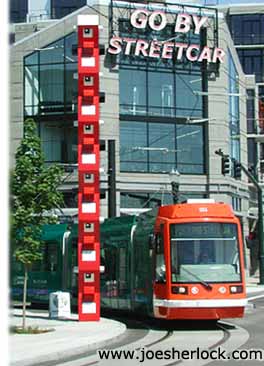 The Trolley Monster That Ate A City: Randal O'Toole - the Antiplanner - wrote, "Despite all the money spent on Portland transit, transit is so unpopular that, of 50,000 new workers gained between 2005 and 2012, fewer than 100 take transit to work. For the Portland urban area as a whole, there were 124,000 new jobs between 2005 and 2012, of which about 700 took transit to work. The Trolley Monster That Ate A City: Randal O'Toole - the Antiplanner - wrote, "Despite all the money spent on Portland transit, transit is so unpopular that, of 50,000 new workers gained between 2005 and 2012, fewer than 100 take transit to work. For the Portland urban area as a whole, there were 124,000 new jobs between 2005 and 2012, of which about 700 took transit to work.
Thanks partly to money stolen from schools by TIF-addicted planners intent on subsidizing TODs, Portland, Oregon high schools have some of the largest classroom sizes and lowest graduation rates in the nation.
The 'creative class' of young people who have been attracted to Portland (most likely by the city's 50 brew pubs) do so little work that they have reduced Portland’s per capita incomes, relative to the rest of the country, by 10%."
These are the soul-patched, fedora-wearing hipster doofuses one sees lounging around Pioneer Square or descending on coffee stands faster than faster than Lena Dunham on a fresh pie.
"Portland has funded only half of its pension obligations and just 4 percent of its health-care obligations, giving it one of the worst records of any city in the nation."
Portland's TriMet transit agency is truly a monster. Most transit systems, including TriMet, only recoup 10-15% or so of their operating expenses from fare revenues. In other words, if public transit became a pay-as-you-go proposition, fares would have to be increased by seven to tenfold. So ... taxpayers are funding this monster. Including you, because the majority of funding comes from the federal budget. Thanks, Obama.
If all of that is not enough to make your blood boil, Eric Fruits, an adjunct professor in the urban studies department at Portland State University and a longtime critic of streetcar transit, has produced data to show that taking the local streetcar is not as fast as walking.
TriMet's transit overlords love social engineering, especially when it comes to travel. The city has become one of the most car-unfriendly places in America because they want you to Go By Streetcar. That's why we rarely patronize Portland's many retailers and restaurants. No decent place to park. (posted 10/7/14, permalink)
The Arrogance Of Mass Transit Overlords: Clark County Washington's mass transit system is named C-TRAN.
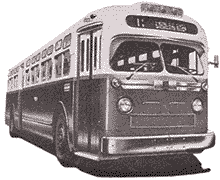 Despite overwhelming opposition by citizens throughout Clark County, the C-TRAN Board of Directors has voted to spend $6.7 million in local money for a rapid transit bus line from downtown Vancouver to Westfield Vancouver Mall. Despite overwhelming opposition by citizens throughout Clark County, the C-TRAN Board of Directors has voted to spend $6.7 million in local money for a rapid transit bus line from downtown Vancouver to Westfield Vancouver Mall.
C-TRAN is a well-known waster of money. Over the years, I've observed many C-TRAN buses cruising around Vancouver with one or two passengers in them. On any given day, less than 5% of the population use public transit to get to work.
County Commissioner David Madore believes higher operating and maintenance costs for the BRT buses will be financially unsustainable, prompting C-TRAN officials to increase taxes to pay the bill.
The specially designed BRT buses would increase tire costs by 67% while getting lower gas mileage than the current buses, Madore told C-TRAN board members. C-TRAN officials have said the BRT buses would save $878,000 per year, but Madore contends two to six new BRT buses running the route for a year would cost $3.73 million while two to six existing hybrid buses can run the route for a year for $540,000 less.
Madore said that C-TRAN's estimate of lower costs on the Fourth Plain route is due to cutting the current 11 buses to five or six once BRT is in place, reducing services on Fourth Plain. The other buses will be reassigned to other routes, so there’s no real cost savings, Madore contends. He summed up the entire program as a "fallacy."
Cost of this bad idea is $53 million, with C-TRAN contributing $6.7 million. The federal government foots the rest of the bill for this boondoggle. It's all part of a nationwide scam. Randal O'Toole recently wrote, "Annual taxpayer subsidies to transit operations have grown from $1.6 billion in 1970 to $24.0 billion in 2012, yet per capita ridership among America's urban residents has declined from 49 to 44 trips per year." (posted 8/11/14, permalink)
Off The Rails: James Lileks has written a humorous and logical indictment of light rail. "There's a big push to bring back streetcars, which are just like buses, except they require iron lines in the pavement and wires overhead, and can't be rerouted. But dang, they look fine in promotional brochures and videos."
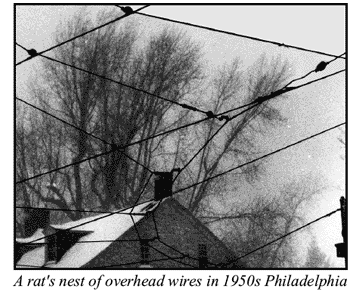 The 'romance' of trolleys blinds people to their disadvantages - expensive to build or modify a line or route, inflexible, unable pull to side of the road for passengers to embark/disembark, the ugliness of all those overhead wires, the nightmare when a streetcar breaks down and on and on. The 'romance' of trolleys blinds people to their disadvantages - expensive to build or modify a line or route, inflexible, unable pull to side of the road for passengers to embark/disembark, the ugliness of all those overhead wires, the nightmare when a streetcar breaks down and on and on.
When it used to cost a few hundred thousand to construct a line, they were called 'trolleys.' Now that the cost is in the billions, they are referred to as 'light rail vehicles' or 'LRVs.' Sounds more sophisticated and NASA-like. I guess bureaucrats think that fancy names and acronyms helps justify the outrageous price.
Lileks notes that silly mass transit schemes are being sold on the basis of ecological guilt. "Really, it's only fair. You're in a car, by yourself, going where you want to go, humming along with the song on the radio, a simple and distinctly American expression of freedom and individuality. You ought to be ashamed of yourself."
The argument for energy-saving is not valid, despite the propaganda from greenies. In 2010, the Randal O'Toole of the Cato Institute wrote, "When taken as a whole, the transit systems for the vast majority of urban areas use far more energy per passenger mile than driving ... Portland's commuter-rail line uses nearly 6,000 BTUs per passenger mile."
Seventy years ago, most mass transit was run by for-profit companies. After World War II, transit usage declined - suburban development and the travel opportunities created by the new interstate highway system encouraged car ownership. By the 1960s, most privately-owned mass transit systems were going -or had gone - bust and were taken over by tax-supported government entities.
Fast forward to 2014: On any given day, less than 5% of the population use public transit to get to work. Even over a two-month period, only about 11% of the population have used it at all.
Today's public transit systems benefit poor people more than anyone else. Those with lower incomes tend to ride mass transit systems "because they value money savings over time savings and convenience" according to one transit authority website. Most transit systems only recoup 10-15% or so of their operating expenses from fare revenues. In other words, if public transit became a pay-as-you-go proposition, fares would have to be increased by seven to tenfold. And, mass transit expenditures have gone up more than 300% adjusted for inflation since 1970 without a corresponding increase in ridership.
That's when the progressives roll out the European Argument, positing that if we only had more mass transit, the interconnectivity would be synergistic. (They neglect to mention that Eurotransit systems remain big money-losers despite the alleged synergy.)
Yes, we all love to use mass transit when touring Europe. Just watch a few episodes of Rick Steves travel show on PBS and you'll be positively drooling over the romance of traveling on an exotic rail line and chatting with colorful local proles while taking in the sights through sparkling clean windows.
But neither Mr. Steves nor his fellow tourists use the transit systems during peak periods or when the weather is nasty. Try getting sardine-packed into a dank subway car with 273 sweaty humans at rush hour in August. (Especially in Europe where hygiene habits are a bit more casual.) Or waiting for a filthy overcrowded bus when it's cold, dark and pouring rain. Not so romantic, eh? That's why people use cars. And will continue to do so.
Mass transit. Nobody wants it. Because it is designed for the masses. Too Karl Marx-y. Yet, the government keeps trying to stuff it down our throats. (posted 4/2/14, permalink)
Transit Troubles: The Southeastern Pennsylvania Transportation Authority (aka - SEPTA) is a metropolitan transportation authority that operates various forms of public transit serving people in and around Philadelphia, PA.

This government agency first took over the Philadelphia Transportation Company (PTC) in 1968. The system included buses, trolleys, trackless trolleys and various elevated and subway systems.
Later, SEPTA took over the Reading Company and the Pennsylvania Railroad commuter railroad lines.
|
|
| While the sign shows the old Pennsylvania Railroad logo, all the commuter trains at center city's Suburban Station are now operated by SEPTA. I was a frequent rider on the old PRR owl-eyes commuter coaches - which ran out of Suburban Station - during my student years at Villanova University. |
Now SEPTA is in trouble. Fares cover only 29% of operating and capital costs.
Actually, that's better than most transit systems - many only recoup 10-15% or so of their operating expenses from fare revenues. In the case of SEPTA, the remaining 71% of funding comes from local governments (7%), the feds (20%) percent (mostly capital funds), leaving the state to cover 42% of the agency's budget.
The state is balking about its subsidy and, without state support, draconian cuts will have to be made.
The AntiPlanner wrote, "Those who have a hard time understanding why the federal government should subsidize local transit programs may find it just as difficult to see why state taxpayers should subsidize programs that almost solely benefit people in the Philadelphia region. To help them understand, SEPTA commissioned a study showing why state taxpayers should spend even more money subsidizing its operations." Good luck with that.
Seventy years ago, most mass transit was run by for-profit companies. In the early 20th Century, ridership grew steadily until the Great Depression. Then it dropped off. During World War II, fuel rationing, tire scarcity and car shortages caused a jump in ridership. After the war, transit usage declined - suburban development and the sprawl created by the new interstate highway system encouraged car ownership. By the 1960s, most privately-owned mass transit systems were going -or had gone - bust and were taken over by tax-supported government entities, like SEPTA.
Today's public transit systems benefit poor people more than anyone else. Those with lower incomes tend to ride mass transit systems "because they value money savings over time savings and convenience" according to the website of C-Tran, a bus system in Vancouver, WA.
Your taxpayer "investment" in creating and operating such mass transit systems is serving a social welfare function. Whether or not this is a 'good' use of your tax dollars is up to you to decide. Your dollars subsidize a small number of users (mostly students and the poor) who are already receiving other subsidies.
The Libertarian in me says this is not a good way to spend taxpayer dollars. I say, "Raise fares." (posted 6/12/13, permalink)
 A Streetcar Named Disaster: Last week, while chomping down a delicious pizza steak at Philly Bilmos, I was reading an article in Willamette Week about the soon-to-be running Eastside Portland streetcar. What a colossal, predestined failure. The line will lose money - big money - right from the get-go and is already planning to offer abysmal service. A Streetcar Named Disaster: Last week, while chomping down a delicious pizza steak at Philly Bilmos, I was reading an article in Willamette Week about the soon-to-be running Eastside Portland streetcar. What a colossal, predestined failure. The line will lose money - big money - right from the get-go and is already planning to offer abysmal service.
"The streetcar - a mode of transportation already notorious in the Pearl District and Southwest Portland for its sluggish pace and long waits between cars - will run even less frequently on all its routes when the Eastside line opens next month."
Eric Fruits, an adjunct professor in the urban studies department at Portland State University and a longtime critic of streetcar transit, has produced data to show that taking the streetcar is not as fast as walking. "It takes 32 minutes to get from OMSI to Powell's Books by foot," he said. "It's a virtual tie. But if you're waiting (at a carstop) an average of 8? minutes, the streetcar loses the race. You can get there faster by walking."
On my last visit to Portland's Westside, I had a chance to see the chaos wrought by the city's mass transit obsession. The track makes very wide swings, knocking out a bunch of parking at every quarter turn. Every trolley stop has a shelter and landing, eliminating even more parking spaces. The streets are narrow and the trolley takes up more than half the street. Why the track radius is so large is difficult to understand; while the Skoda streetcars are quite long - 66 feet, they are double-articulated - making them 22 feet long for tuning purposes - and should be able to navigate extremely tight-radius curves.
The old PCC trolley cars of the 1930s were non-articulated, 46 feet long but had swivel trucks which allowed for tight turns even on the narrow lanes of South Philadelphia, the Bronx, Baltimore and old Boston.
During our entire time in the area, including exposure at peak commuting hours, I never saw an actual streetcar. I had the same experience when we last visited the Pearl District. It makes me wonder if TriMet actually runs any of the damn things or if they laid track just to screw up parking in an attempt to further the agency's anti-car agenda.
Professor Fruits said that he has "never seen evidence that a streetcar is a superior form of urban transportation to a bus." Actually, TriMet's buses lose lots of money, too. Fare revenues cover less than 15% of operating expenses. The rest is paid for by taxpayers, including you since these transit lines are funded by various Federal grants, bequests and matching funds.
Nevertheless, Portland's TriMet transit overlords love social engineering, especially when it comes to travel. The city has become one of the most car-unfriendly places in America because they want you to Go By (nonexistent) Streetcar. That's why we rarely patronize Portland's many retailers and restaurants. No decent place to park. (posted 9/6/12, permalink)
Ever Been To Grants Pass? I have - several times. It's a nice, if somewhat isolated little city (population 30,500 or so) in southern Oregon on Interstate 5. I never knew that it had a transit system but it does and, according to The Antiplanner, it's quite a boondoggle.
"Grants Pass decided to boost transit ridership by building five bus shelters using federal Congestion Mitigation/Air Quality (CMAQ) funds." Each one cost $106,000. "By comparison, the nearby city of Roseburg, Oregon (population 21,000) built similar (though perhaps not quite as pretty) shelters for $7,000 to $11,000 each."
The transit system in Grants Pass uses wastes your tax dollars. Transit riders "pay only a bit more than 10% of the cost of the system, and local taxpayers only pay about 2.6%. All the rest comes from federal and state funds." And it's a wasteful and inefficient little bus company which "carries roughly 500 passengers a day. That's not very good considering it has two bus routes that go 24 times a day, two more that go twelve times a day and two long-distance routes that go three times a day, plus demand-responsive service for seniors and handicapped passengers. That's an average of about 6.5 riders per bus trip, with a taxpayer subsidy of about $9 per ride."
As of 2009, most of the little buses had 21 seats, and "generously assuming each rider rode half the distance of each route (most of the routes are circular), that means an average of 15% of the seats are full. That's probably optimistic, which suggests the buses aren't very good for the environment either." (posted 1/27/12, permalink)
Now You Can Waste Both Time And Energy! Mass transit - it there anything it can't do?
From The Antiplanner: " ... the average car uses about 3,500 BTUs per passenger mile. By comparison, the average transit vehicle used about 3,440 BTUs per passenger mile. Getting people into cars like the Prius (1,700 BTUs per passenger mile) will do more to save energy and reduce pollution than expanding transit systems."
"When taken as a whole, the transit systems for the vast majority of urban areas use far more energy per passenger mile than driving ... Portland's commuter-rail line uses nearly 6,000 BTUs per passenger mile."
Save the planet - drive to work. (posted 1/18/12, permalink)
 Transit Madness: On November 8th, Vancouver Washington (and some of Clark County) voters will be asked to raise sales taxes in order to "preserve existing bus service." Transit Madness: On November 8th, Vancouver Washington (and some of Clark County) voters will be asked to raise sales taxes in order to "preserve existing bus service."
Without the sales tax increase, says C-Tran, the transit agency, "C-Tran would need to implement a system-wide service reduction of about 35% by early to mid 2013."
The Anti-Planner has pointed out, "It turns out that is a lie. An accountant named Tiffany Couch has scrutinized C-Tran's budget and projected costs and revenues and concluded that existing taxes are sufficient to maintain bus service for many years."
Why does C-Tran say that service will decline without the tax increase? The answer, says Couch, is that C-Tran has already decided it wants to build a light-rail line - its first one - connecting with Portland's light rail. Without the tax increase, C-Tran will have to cut bus service in order to pay for the light rail.
C-Tran looks across the river at Portland's Tri-Met with all its insane, underutilized streetcar and light-rail lines and develops a severe case of trolley-envy.
I couldn't vote against this initiative because my neighborhood has been gerrymandered out of the C-Tran voting district. This was done a few years ago when the Clark County Democrats realized that many rural residents were against mass transit wastage, so they redrew the C-Tran service boundaries to exclude such foes. (posted 11/8/11, permalink)
Update: Unfortunately, the measure was passed by voters.
"Baby Face ... You've Got The Cutest Little ..." Portland's TriMet transit agency - a documented waster of money, especially on light rail and streetcar projects - is now facing a $12 million to $17 million budget shortfall next year. Nevertheless, it plans to spend $250,000 on a hideous giant sculpture of a deer with a human baby face.
"The agency has already cut bus service by 13% and light-rail service by 10% in the last two years. Yet it is spending at least $3 million on 'art' as part of its $200-million-per-mile light-rail line to Milwaukie, one of the most wasteful rail projects ever."
It's important to remember that most transit systems, including TriMet, only recoup 10-15% or so of their operating expenses from fare revenues. In other words, if public transit became a pay-as-you-go proposition, fares would have to be increased by seven to tenfold.
Today's public transit systems benefit poor people more than anyone else. Those with lower incomes tend to ride mass transit systems "because they value money savings over time savings and convenience."
Randall O'Toole has written, "After all, the most important thing is to keep Portland weird, not to actually provide transportation to people who need it. In furtherance of that goal, TriMet recently hired a multicultural manager and a transit equity manager, no doubt paying both more than $100,000 a year." (posted 10/31/11, permalink)
So Many Tracks; So Few Passengers: The Cascade Policy Institute has questioned whether costly-to-build mass transit options in Portland, Oregon are really being used by the public.
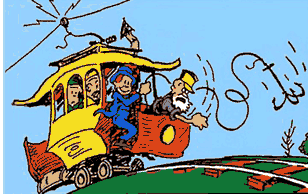 That didn't stop Head Moron, chronic liar and U.S. Transportation Secretary Ray 'Stop Driving Your Toyotas Immediately' LaHood from singling out the city's "priorities" for praise: "By adding innovative transit opportunities, Portland has become a model livable community, a city where public transportation brings housing closer to jobs, schools, and essential services." That didn't stop Head Moron, chronic liar and U.S. Transportation Secretary Ray 'Stop Driving Your Toyotas Immediately' LaHood from singling out the city's "priorities" for praise: "By adding innovative transit opportunities, Portland has become a model livable community, a city where public transportation brings housing closer to jobs, schools, and essential services."
Cascade President John Charles, Jr. said in a statement, "Light rail is actually a low-capacity system and the (Portland) streetcar is simply irrelevant. TriMet's buses carries two-thirds of all regional transit trips on a daily basis, and that's the service that should be recognized as high-capacity transit. Unfortunately, bus service is being sacrificed by TriMet in order to build costly new rail lines that carry relatively few people."
Streetcars? What streetcars!? I've seen the tracks for them, but no cars in Portland. And, the primary riders of the Max light rail line seem to be students, hobos and gang members.
Portland's Tri-Met transit overlords love social engineering, especially when it comes to travel. The city has become one of the most car-unfriendly places in America. That's why we rarely patronize Portland's many retailers and restaurants. (posted 5/23/11, permalink)
End Of The Line For This Dude: A 20-year-old graffiti artist vandal was struck and killed by a subway train in Brooklyn yesterday. He was hit by a Manhattan-bound 'D' train at the 59th St. station while creating his "art." Transit officials said the motorman tried to stop the train but couldn't bring it to a halt in time.
And the artist became One with his Art. Splat! (posted 5/17/11, permalink)
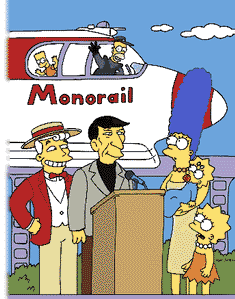 Rails To Nowhere: Channelling his inner Lyle Langley during last week's State of the Union address, President Obama proposed to build a high-speed rail network reaching 80% of Americans within 25 years. Rails To Nowhere: Channelling his inner Lyle Langley during last week's State of the Union address, President Obama proposed to build a high-speed rail network reaching 80% of Americans within 25 years.
In 2008, U.S. airplanes logged 583 billion passenger miles, while the entire Amtrak system accounted for just 6 billion passenger miles. Rail service - fast or slow - is a thing of the past. Passenger travel by rail no longer makes economic sense.
Rail is a fixed route transit system, less flexible and too time consuming compared to the more air travel. As major airlines have exponentially increased connectivity with cities of all sizes and locations, competition has also reduced the relative cost of air travel to the point most households can get to their long-distance destinations faster and cheaper via air. Or, sometimes, intercity bus.
Transportation expert Randall O'Toole has written that "we shouldn't expect the federal government to do things for us that the market can do better (and at no cost to taxpayers). If private investors won't build high-speed rail, maybe we don't really need high-speed rail."
The costs of reaching 80% of Americans with high speed rail transit would be astronomical. Be for such money is spent, taxpayers would do well to remember the lessons of The Simpsons' Monorail Song:
• Barney: "What about us brain-dead slobs?" Lyle Langley: "You'll be given cushy jobs." Most federal projects are featherbedded in favor of unions and minority hires. Many of the jobs are makework.
• Marge: "But Main Street's still all cracked and broken ..." Bart: "Sorry, Mom, the mob has spoken!" Feeling-good trumps common sense and Obama distracts us with the promise of shiny fast trains, while serious problems - Social Security, Medicare, Medicaid, and interest on the national debt, which account for more than 75% of federal expenditures - are ignored.
Let's sing the big finish together: "Monorail! ... Monorail! ... Monorail!" (posted 2/1/11, permalink)
Ticket To Ride: A proposed Oregon streetcar will cost taxpayers about $20 per passenger ride - one way.
But hey, it's only money. Your money. (posted 12/9/10, permalink)
Unfare: C-Tran, Clark County's useless public transit company, is getting $4.5 million in federal funds.
The bulk of the money will go toward "replacing aging fare boxes" on some of C-Tran's 105 buses. That probably works out to $50,000 per fare box.
What?! Has C-Tran never heard of competitive bidding? I can't imagine a fare box costing more than $1-3,000. And how come the old ones can't be refurbished?
This another U.S. Transportation Secretary Ray LaHood (car-hater extraordinaire) boondoggle, brought to you by the Obama Administration. This is one more example of Your Tax Dollars At Waste. (posted 10/8/10, permalink)
|
|
 During our September 2010 visit to Yosemite National Park, we were subjected to sanctimonious environmental lectures by park guides who were preachier than a coven of vegans at a meatpackers convention. Everything must be 'sustainable', 'natural' or 'environmentally sound'. During our September 2010 visit to Yosemite National Park, we were subjected to sanctimonious environmental lectures by park guides who were preachier than a coven of vegans at a meatpackers convention. Everything must be 'sustainable', 'natural' or 'environmentally sound'.
Some of the smugness evaporated when the hybrid bus broke down.
As Nelson Muntz of The Simpsons would say, "Haw, haw. Your greenie technology is useless."
Read more about the folly of hybrid buses here. (posted 10/1/10, permalink)
|
Transit Fascists: The PATCO Speedline is an elevated/subway train which runs between downtown Philadelphia and Camden County, New Jersey. Opened in 1969, it was once the pride of modern mass transit. I was a regular rider in the 1970s, when I commuted from Jersey to Rohm & Haas Headquarters near Independence Hall. At the time it was called the Lindenwold Hi-Speed line.
In its prime, PATCO was the only U.S. mass transit system which consistently made an operating profit each year.
PATCO trains travel across the Ben Franklin Bridge. The lines were constructed below the deck sightline, so the view of the river for motorists and pedestrians would be unimpaired. Even the train riders experience river views.
While the line still transports 33,000 people daily and is one of only four U.S. rapid transit systems operating 24 hours per day, ridership has fallen sharply since its peak in 1990.
Commuters who rode PATCO trains last week were surprised by random searches of their clothing, pockets, bags and vehicles on their morning trip to work. Twelve Transportation Security Administration (TSA) screeners, armed with an explosive-sniffing K-9, checked 663 commuter bags randomly selected from the morning rush at the Lindenwold station last Tuesday, causing rush-hour chaos and massive backups. (TSA=Thousands Standing Around)
Was there a bomb scare? Internet chatter from the Middle East? Veiled threats by veiled people? No. The authorities did it because they could. Delaware River Port Authority Fuhrer Police Chief David McClintock said, "We can conduct any kind of search we want."
This is how a Police State is formed. One step at a time. (posted 9/13/10, permalink)
Less With More: Randal O'Toole has noted that "since 1970, the number of workers needed to operate America's public transit systems has increased by 180%."
Meanwhile, "ridership on buses, trolley buses, light rail, and heavy rail (again, the only modes shown in 1970), grew by a mere 32%. That means each transit worker produced 53,115 transit trips in 1970, but only 26,314 trips by all modes in 2008. In other words, by any measure, transit productivity has declined by more than 50%."
"About the only other industry that has seen a similar loss in productivity during the same time period is education - which, like transit, is government-run."
Government enterprise - a stunning example of reverse productivity. (posted 7/22/10, permalink)
Wrong Side Of The Tracks: For as long as I can remember, Northwest Portland has been the artsy and gay district. It is a pleasant section of town filled with mature tree cover, trendy restaurants, galleries and small shops. Parking has always been at a premium due to skinny streets and a plethora of visitors.
Several years ago, Portland decided to run a streetcar line through the narrow NW streets. The streetcar swings west from the Pearl District on NW Northrup St., then south on NW 23rd, passing Legacy Good Samaritan Hospital. Then it turns east on NW Lovejoy, heading back to the Pearl and, eventually, Portland State University.
 As a side note, Lovejoy St. inspired the names of The Simpson characters Reverend Lovejoy and his ever-concerned 'what about the children' wife, Helen. As a side note, Lovejoy St. inspired the names of The Simpson characters Reverend Lovejoy and his ever-concerned 'what about the children' wife, Helen.
During a recent hospital visit, I had a chance to see the chaos wrought by Portland's mass transit obsession. The track makes very wide swings, knocking out a bunch of parking at every quarter turn. Every trolley stop has a shelter and landing, eliminating even more parking spaces. The streets are narrow and the trolley takes up more than half the street. Why the track radius is so large is difficult to understand; while the Skoda streetcars are quite long - 66 feet, they are double articulated and should be able to navigate extremely tight-radius curves.
During our entire time in the area, including exposure at peak commuting hours, I never saw an actual streetcar. I had the same experience when we last visited the Pearl District. It makes me wonder if TriMet actually runs any of the damn things or if they laid track just to screw up parking in an attempt to further the agency's anti-car agenda.
The old PCC trolley cars of the 1930s were 46 feet long and had swivel trucks which allowed for tight turns even on the narrow lanes of South Philadelphia, the Bronx, Baltimore and old Boston. And, for those really close quarters, there were always Birney cars - nimble little trolleys which could turn on the proverbial dime.
TriMet's railcar madness is spreading like a fast-growing cancer, killing everything that's good in the River City. I'm glad I don't live in Portland. (posted 7/12/10, permalink)
Export Market: Light rail exports crime to new neighborhoods.
The Clackamas County (OR) sheriff has said he's concerned the new Portland MAX line is dropping off "more than passengers at Clackamas Town Center; it's dropping off crime too. In the five months since the MAX Green line first arrived, Sheriff Craig Roberts says crime in the surrounding area is up 32% this year and calls for service are up 56% compared to 2009."
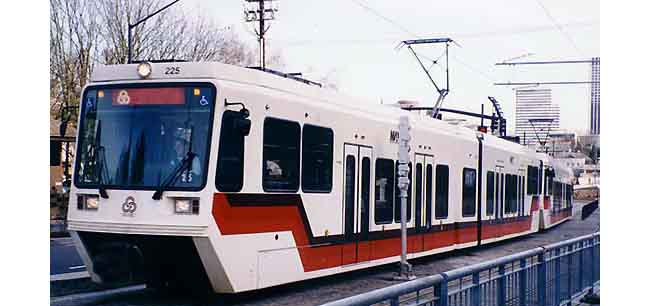
I remember when Gresham was a nice, sleepy little town east of Portland. Then TriMet came along and killed the neighborhood.
Before the light-rail line opened in 1986, Gresham was "a neighborhood of well-maintained owner-occupied single-family residences." The light-rail line "split the area in two and messed up the traffic at two of the major intersections, one of which was the location of the Fred Meyer store. Then the New Urbanist mayor of Gresham pushed through a policy to encourage the construction of hundreds and hundreds of low-cost government-supported apartments amid the owner-occupied homes." That policy included rezoning the neighborhood for minimum-density apartments and providing below-market land sales and tax-increment financed subsidies to those apartments.
"Instead of attracting yuppies looking for walkable neighborhoods, the apartments drew low-income families displaced from Portland neighborhoods that were being gentrified by people who - thanks to the urban-growth boundary - could not find affordable single-family homes elsewhere. The light rail brought in drug dealers and other shady characters. Soon the neighborhood was controlled by gangs and residents were afraid to ride the light rail because of the threat of violence."
No light rail for Clark County, WA. We have enough crime already, thank you. (posted 6/11/10, permalink)
Less Tax Money = Less Waste: I've written before about the many sightings of C-Tran running mostly-empty buses on routes throughout the area. Now there will be fewer of them.
"Clark County's bus system is cutting back on low-ridership routes starting in January to help close a $6 million budget gap caused by the recession." Why? "Sales taxes make up 60 percent of the system's operating budget, but have fallen because of the prolonged downturn." (posted 10/23/09, permalink)
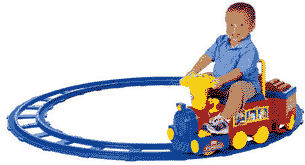 This Is Urban Planning? The newly opened Seattle-area Sound Transit light-rail line has no park-and-ride lots or garages. Street parking varies severely-restricted to nonexistent. If you live in the area, maybe you should plan on building your own personal light rail line to get from home to a Sound Transit rail stop. This Is Urban Planning? The newly opened Seattle-area Sound Transit light-rail line has no park-and-ride lots or garages. Street parking varies severely-restricted to nonexistent. If you live in the area, maybe you should plan on building your own personal light rail line to get from home to a Sound Transit rail stop.
When asked, Seattle DOT smugly replied that people should take a bus to the station.
For years, the city of Seattle has had a policy of discouraging park-and-rides. Garages, said Rick Sheridan, spokesman for the Seattle Department of Transportation, "create traffic and don't add to the quality of life of a neighborhood."
Of course, bums and beggars don't add to a neighborhood's "quality of life" either but Seattle openly encourages growth of its ever-increasing homeless population. (posted 7/24/09, permalink)
Money-Burning Mass Transit: Testifying before the U.S. Senate Committee on Banking, Housing and Urban Affairs (chaired by that money-wasting, reprehensible Christopher Dodd), Randal O'Toole, the Antiplanner, noted that, "despite increasing transit subsidies by 1,250% (adjusted for inflation) since 1970, transit travel has declined from 49 to 45 trips per urban resident and transit's share of urban travel has declined from 4.0% to 1.6%."
He continued, "In a very real sense, transit is just like the British coal, rail, and other nationalized industries in the 1960s: its main purpose is no longer transportation but to meet other political goals such as keeping transit workers employed and construction contracts going to transit builders. If transit were private, no one would argue that we have to make the world less convenient and more expensive for the 95% of people who travel by car so that it will be more convenient for the 1 or 2 percent who travel by transit."
Mass Transit is a lie. It's not for the masses. It's for a select few. And a colossal waste of taxpayer dollars. (posted 7/13/09, permalink)
 Your Tax Dollars At Waste ... Again: C-Tran, Clark County's transit agency, received $5.8 million through federal economic stimulus funding. The money will enable the agency to purchase three new hybrid buses and 12 new minivans, as well as pay for assorted upgrades to communications and maintenance for its existing fleet of 110 buses and 67 C-Van paratransit vehicles. Your Tax Dollars At Waste ... Again: C-Tran, Clark County's transit agency, received $5.8 million through federal economic stimulus funding. The money will enable the agency to purchase three new hybrid buses and 12 new minivans, as well as pay for assorted upgrades to communications and maintenance for its existing fleet of 110 buses and 67 C-Van paratransit vehicles.
These 177 vehicles are the ones I see cruising around Vancouver with one or two passengers in them. C-Tran spokesman Scott Patterson said. "We are experiencing a serious downturn in revenue." In other words, nobody's riding the buses already on the road. So, why is our tax money being used to buy more?
The grant is one of 343 totalling $3.2 billion to improve public transit across the country. The Federal Transit Administration expects to award another $5.2 billion worth of transit grants through the end of the year. (posted 7/13/09, permalink)
Mass Energy Waste: Randal O'Toole, the Antiplanner, has written, "Public transit buses tend to be some the least energy-efficient vehicles around because agencies tend to buy really big buses (why not? The feds pay for them), and they run around empty much of the time. But private intercity buses are some of the most energy efficient vehicles because the private operators have an incentive to fill them up." Think Greyhound, Trailways, Coach USA, etc.
Randal reported, "When it comes to energy consumption per passenger mile, the real waste is generated by public transit agencies and Amtrak. Instead of trying to fill seats, they are politically driven to provide service to all taxpayers, regardless of population density or demand."
Every time I see a C-Tran bus around here, it is more than 90% empty.
"Meanwhile, transit agencies build light-rail lines to wealthy suburbs with three cars in every garage. With capacities of more than 170, the average light-rail car in Baltimore and Denver carries less than 15 people, while San Jose’s carries 16. For that we need to spend $40 million a mile on track and $3 million per railcar vs. $300,000 for a bus. ... The environmental impact statement for a Portland, Oregon light-rail line found it would take 171 years of annual energy savings to repay the energy cost of construction." But they built it anyway.

The article concludes, "If we really wanted to save energy, we would privatize transit, privatize Amtrak and sell highways to private entrepreneurs who would have an incentive to reduce the congestion that wastes nearly 3 billion gallons of fuel each year. But of course, the real goal of the rail people is not to save energy but to reshape American lifestyles. They just can't stand to see people enjoying the freedom of being able to go where they want, when they want to get there."
Maybe if buses and railcars were covered with mirrors, they could be solar-powered. No service at night or on cloudy days, though. (posted 6/29/09, permalink)
Department Of Transportation = Department Of Mass Transit: At a National Press Club speech intended to promote the Department of Transportation's (DOT) stimulus spending initiatives, Transportation Secretary Ray LaHood explained how his policies are designed to discourage the ownership and use of automobiles. Although many imagine road building when 'shovel-ready' projects are mentioned, the only efforts highlighted by LaHood as worthy of receiving federal taxpayer subsidy include buses, light rail and other forms of multi-modal transit.
"We have $8 billion," LaHood said. "You're going to see new buses; you're going to see ability of transit districts to really have the equipment ... And we'll begin at DOT to set a standard for our ability to get out of the recession, get people back to work in good-paying jobs."
LaHood says some of those federally-funded jobs involve driving buses. I don't know if he means big buses or a bunch of aging hippies driving old VW Microbuses around Eugene, OR, Portland's Pearl District and Bellingham, WA.
Mass transit almost never works. I've posted extensively about the folly of public transit here and on this web page.
It's your tax dollars at waste. (posted 5/28/09, permalink)
Bad Idea: Washington state and California officials have held preliminary discussions about a high-speed, state-of-the-art rail line that would connect San Diego and Vancouver, B.C., with trains that could travel in excess of 200 miles per hour. "The 1,500-mile line, by some estimates, could cost between $10 million and $45 million per mile to build." That could be almost $70 billion dollars. Constructing a truly high-speed West Coast rail corridor wouldn't be easy, requiring entirely new rails and a new corridor that smoothed out grades and corners.
At present, passenger trains share the tracks with freight trains on a BNSF mainline, and sometimes must wait because of track tie-ups. The Amtrack Cascades between Eugene, OR, and Seattle averaged a 64% on-time performance for 2008. (posted 5/20/09, permalink)
Almost Eighty Years Later; Almost Eighty Percent Uglier: In 1931, new railcars were introduced on the Philadelphia to Norristown transit line. The railway was then known as the Pennsylvania & Western (nicknamed the Piss & Whistle by locals); the new cars were built by Brill of Philadelphia.
The aluminum railcars had a streamlined design (resulting from wind-tunnel testing of scale models), featured rounded parabolic ends and could hit speeds as high as 92 mph. These amazing cars remained in service for 59 years. I rode them many times commuting to college. The replacement cars are Fisher-Price boxy and probably have the aerodynamics of a brick.
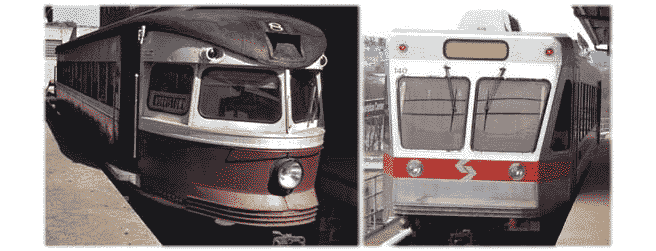
The line on which the new cars run is now controlled by SEPTA and is known as the Norristown High-Speed Line. So much for progress. (posted 4/6/09, permalink)
Fiscal Levitation: Buried in the details of the mass transit section of the recently-passed and signed Spendulus Package (aka - No Deadbeat Left Behind™) is $45 million to pay for environmental studies of a Disneyland to Las Vegas high-speed MagLev rail line, something that sounds like parody but is actually a pet project of Harry Reid, Democratic Senate Majority Leader. The 311-mph train could make the trip from Sin City to Tomorrowland in less than two hours, according to backers - at a cost of mega-billions.
Maglev costs about 10 times as much as regular rail. There's only one commercial maglev line in the world - the Shanghai Transrapid which travels from Pudong, on the Shanghai subway line to Pudong International Airport - a distance of less than 19 miles. There has never been a commercial long distance inter-city maglev rail line built.
The Shanghai maglev cost $1.33 billion to build. So the construction cost alone would be $70 million per mile (and that's with Chinese labor). Constructing a line from Disneyland to Las Vegas - a distance of almost 300 miles - would surely cost well over 20 billion dollars. This is an absurdly high number. And, in America - a large country with big distances between population centers - passenger rail never pays off.
The heyday of rail passenger service in America was in the 1920s. In those times, railroads were profitable and passengers were happy. The depression of the 1930s ended all that. The Pennsylvania Railroad's experience was typical. Like the rest of the nation's railroads, the Pennsy never earned a profit from passenger service since 1946, despite multi-million dollar investments in passenger equipment and facilities in the years following World War II. Competition from the use of automobiles for medium-distance intercity trips prevented the railroads from increasing fares enough to cover soaring labor and material costs.
Today, even in the densely Northeast Corridor, Amtrak can't make money. Not even with its high-speed, premium priced Acela trains. Since its inception in 1971, Amtrak has never recorded a profit while receiving more than $40 billion in federal funding since its inception.
Amtrak's annual operating deficit for the entire system is approximately $500 million dollars. The rest of Amtrak's deficit goes to debt service, capital projects on the Amtrak-owned Northeast Corridor infrastructure and Railroad Retirement costs.
Amtrak started Acela high-speed train service in late 2000. Each train can make the trip between New York and Washington in 2 hours, 28 minutes, with a top speed of 150 mph. Revenue from Acela fares was $403.5 million, or 27 percent of Amtrak's ticket sales. Acela tickets can be more than twice as expensive as those for slower, so-called regional trains between Washington and New York. Trains out of New York City account for over 60% of Amtrak's gross revenue.
In the 1940s to the 1960s, the Pennsylvania Railroad ran 'clockers' - hourly trains (22 per day, over 150 per week) between Philadelphia and New York; single electric locomotives carrying eight to ten passenger cars. Acela trains have two locomotives and six passenger cars; there are only 32 scheduled Acela runs per week.
Last year, Republican Senator John E. Sununu New Hampshire offered an amendment that would have forbidden Amtrak from running trains with government per-passenger subsidies that exceed $200. He asked, "How much money should the taxpayers be asked to spend on a business that is losing money?" His proposal was voted down by a wide margin in the Democrat-controlled Congress.
Passenger railroads in Japan and Great Britain are now mostly in private hands and are generally profitable.
Creating new rail networks will not solve America's woes - it will only create another unprofitable quasi-government entity. Privatization would weed out the unprofitable routes and maintain/create profitable, market-based transportation entities. (posted 3/30/09, permalink)
More mass transit musings can be found here.
Other Pages Of Interest
copyright 2009-16 - Joseph M. Sherlock - All applicable rights reserved
Disclaimer
The facts presented in this blog are based on my best guesses and my substantially faulty geezer memory. The opinions expressed herein are strictly those of the author and are protected by the U.S. Constitution. Probably.
Spelling, punctuation and syntax errors are cheerfully repaired when I find them; grudgingly fixed when you do.
If I have slandered any brands of automobiles, either expressly or inadvertently, they're most likely crap cars and deserve it. Automobile manufacturers should be aware that they always have the option of trying to change my mind by providing me with vehicles to test drive.
If I have slandered any people or corporations in this blog, either expressly or inadvertently, they should buy me strong drinks (and an expensive meal) and try to prove to me that they're not the jerks I've portrayed them to be. If you're buying, I'm willing to listen.
Don't be shy - try a bribe. It might help.
|
|